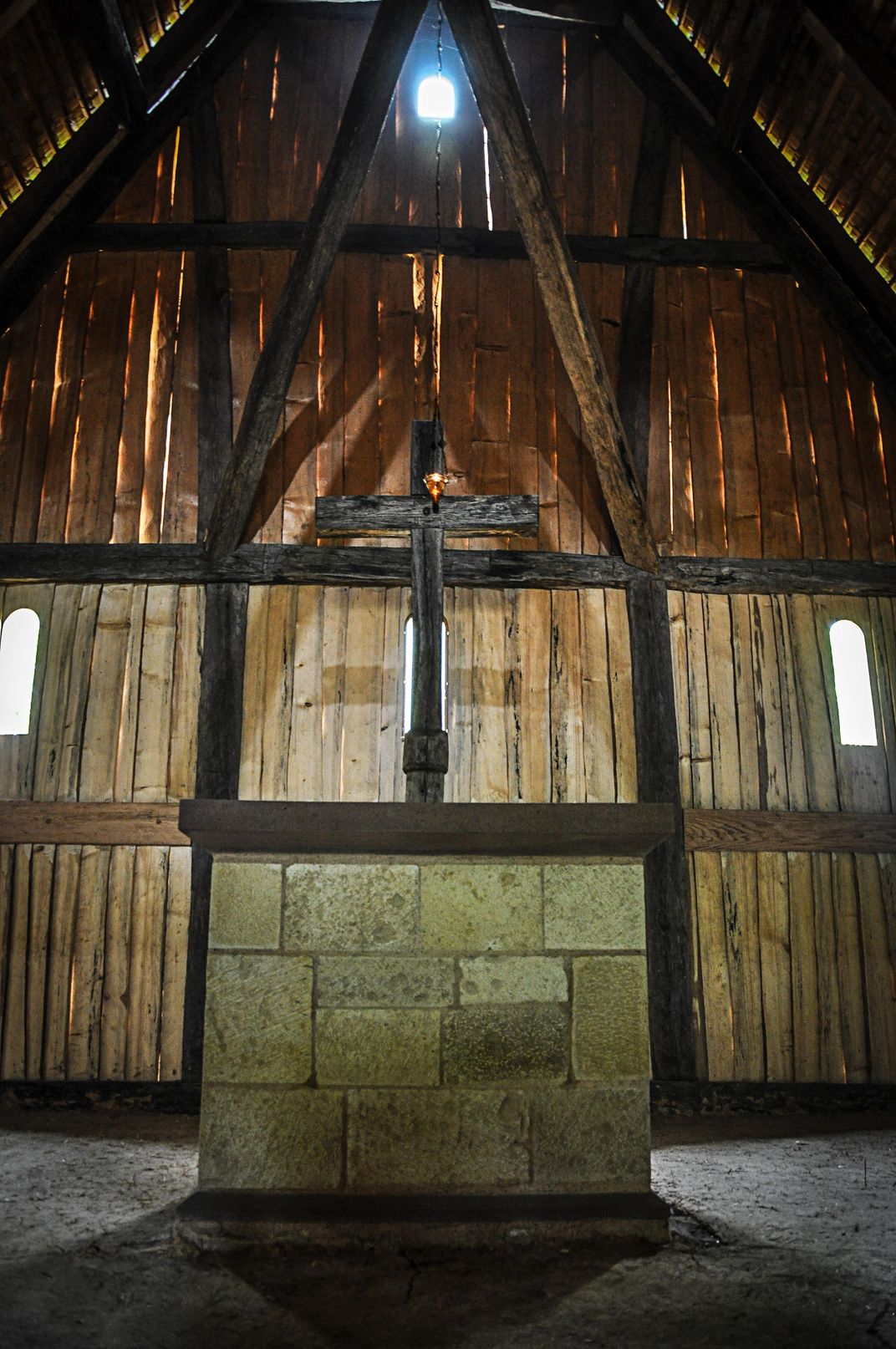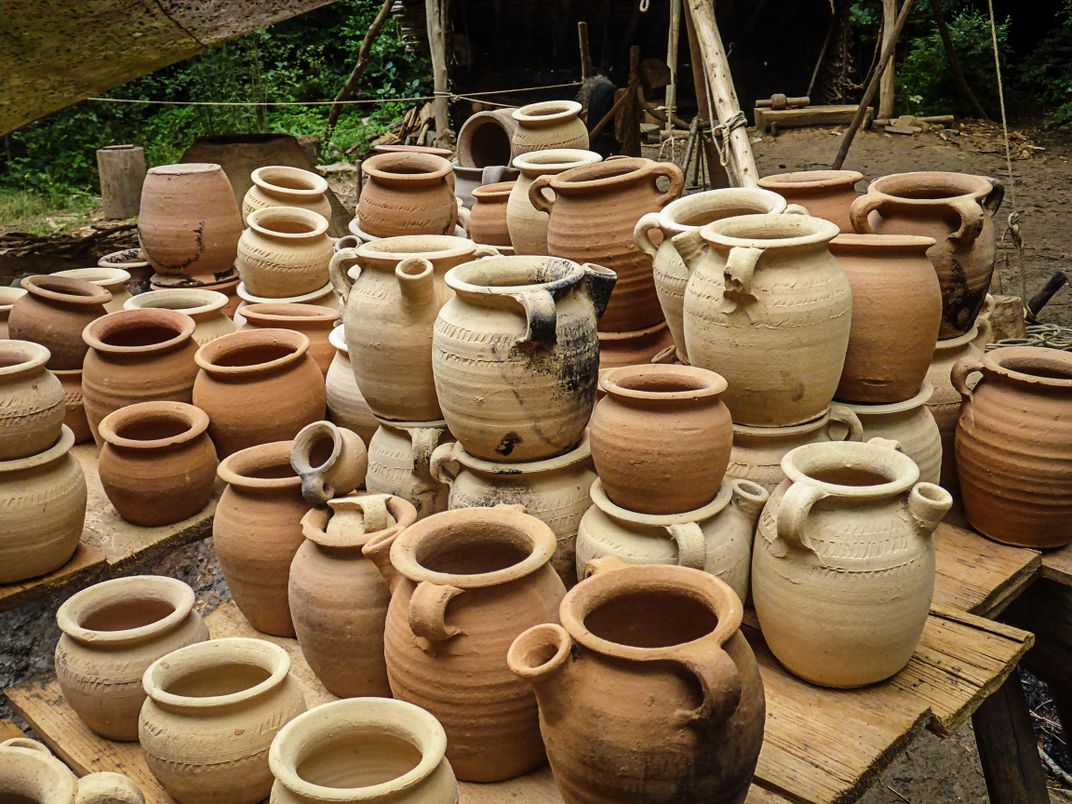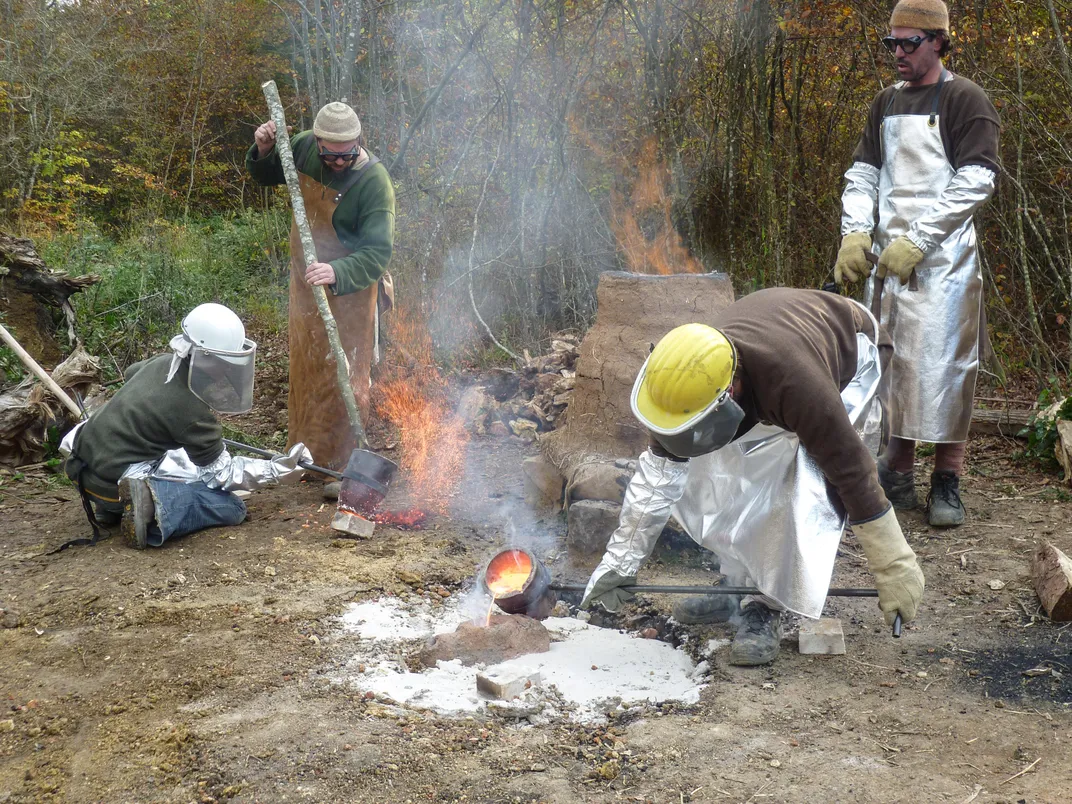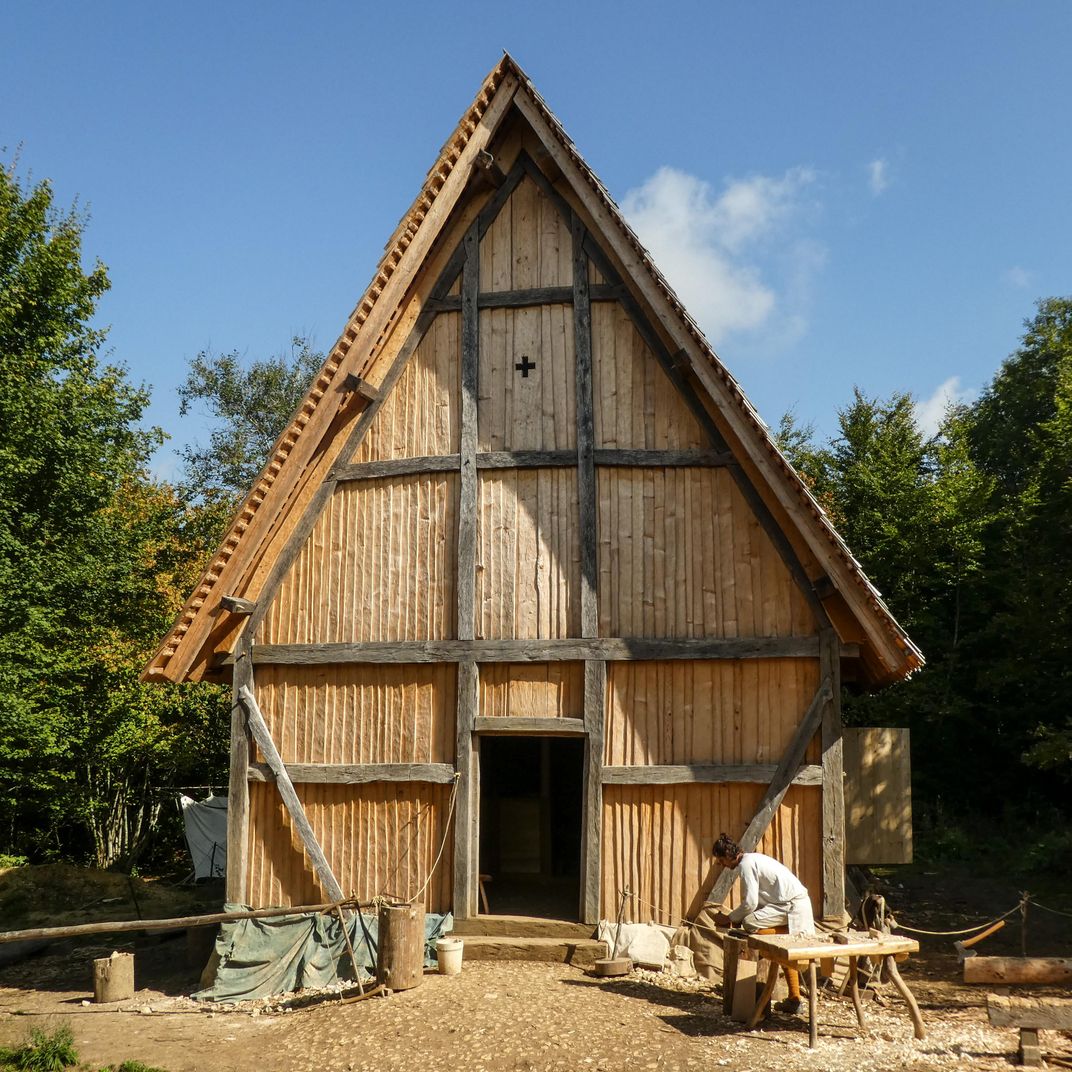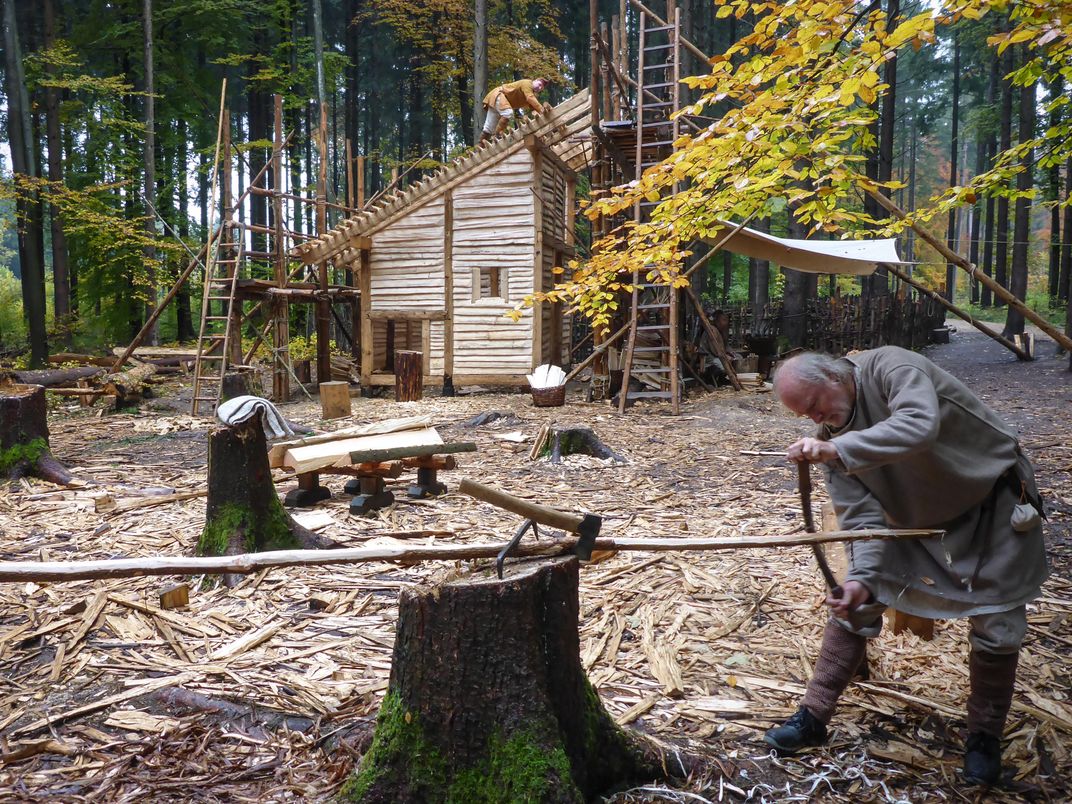The World’s Weirdest Architectural Feat Involves Building a Cathedral With Ninth-Century Tools
In a German forest, artisans fleeing modernity build a time machine to the medieval age
/https://tf-cmsv2-smithsonianmag-media.s3.amazonaws.com/filer/e4/9d/e49d30d7-ce78-40be-889d-380de8ff5f93/may2019_e14_prologue.jpg)
Andreas Herzog, a woodworker with a long, bushy gray beard, grabs a wooden mallet, takes aim at a board of beech suspended by ropes and strikes it 12 times. The wood on wood sounds surprisingly metallic—a sharp chime that echoes off the canopy of Germany’s Black Forest.
For Benedictine monks in the Middle Ages, the sound of a semantron was the typical beginning of a workday. For the 25 craftspeople and 15 volunteers at Campus Galli, it’s the beginning of a new century.
They set down their coffees, turn off their phones and bring the glade to life with a birdsong of tools: the pleasant chink of chisels against stone, the thud of axes against tree trunks and the gentle scrape of steel sharpened against sandstone.
Campus Galli differs from almost all other living history projects (such as Colonial Williamsburg in Virginia) in its strict adherence to period authenticity and its fantastically audacious aim: to build a large stone cathedral and about 40 other buildings based on ninth-century plans using medieval materials and methods. It could take over a hundred years to finish what may well be the modern world’s weirdest and most ambitious architectural feat.
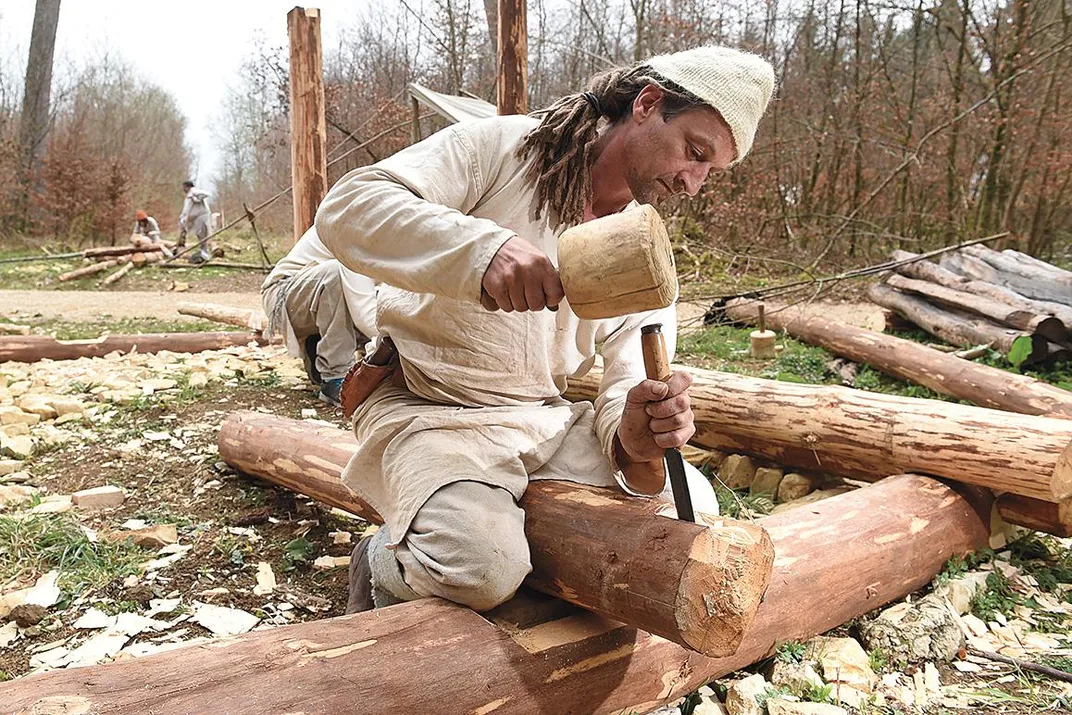
And as at any self-respecting “open-air museum,” the employees dress in period attire, which isn’t so bad, I realize, as I pull on white linen pants and a tunic, as well as a brown monastic scapular made of fulled wool (sort of an apron that covers one’s front and backside), and a beige cape over my chest and shoulders. Only the boots are uncomfortable—a cheap set of black modern steel-toed boots required by European work safety regulations that are one of the campus’s few modern compromises. (Others include torch masks, safety goggles and whatever underwear you want.)
I spot a group of four men wearing the same pajama-type clothing I have on, except theirs is covered in dirt. They are industriously hacking away at the last roots of a tree with handmade axes and hatchets. One of the workers is Thomas Lettenmayer, a mechanical engineer who spends his vacations volunteering at Campus Galli. He’s been working to remove this stump for the past two days, a process that a gas-powered stump grinder could complete in minutes. But he’s got a big smile on his face, and he and the other men laugh triumphantly when the last root breaks.
“Here, you can think better about life,” says Lettenmayer, when I ask him why he spends his free time doing dirty work. “Here, you can calm down.”
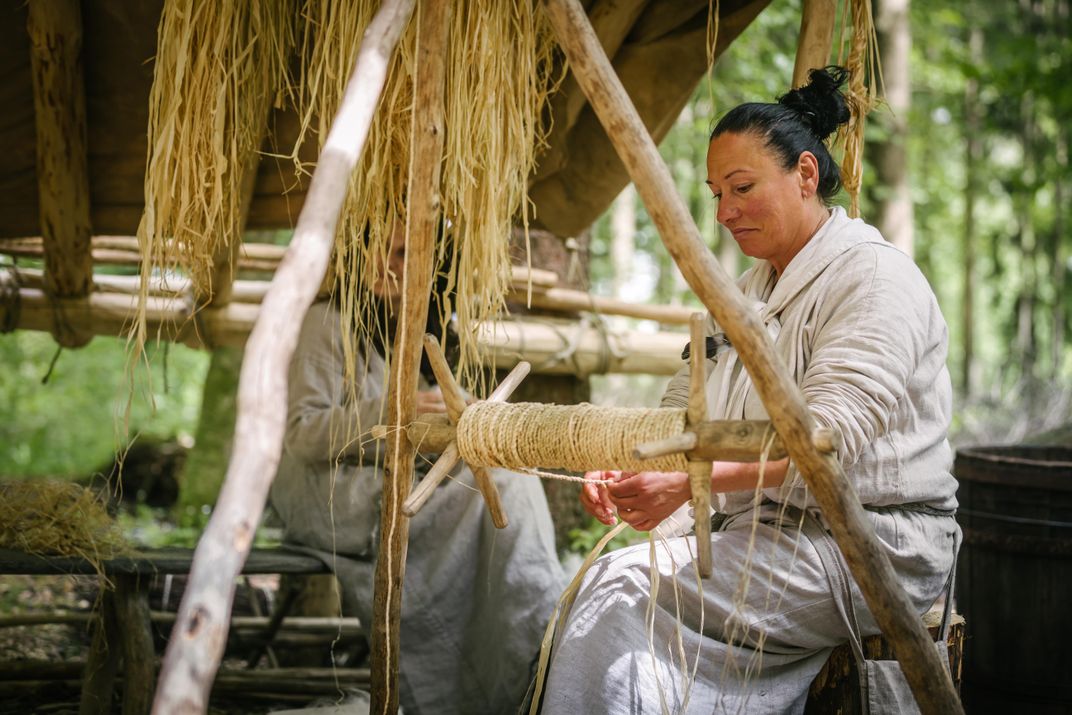
At the stoneworks, Jens Lautenschlager, a thickset and brown-bearded journeyman stonemason of 15 years, is shaping a block of sandstone with a chisel he’d just warmed by a fire, sending mini-meteors and puffs of dust flying with each hammer strike. Lautenschlager tells me he’s a mason because he likes to “keep buildings alive”: “Make a stone, fit it in. When I’m gone, the stone is still there.”
The transformation from stone to brick is a time-consuming one. From a quarry about 50 miles away, the stone is transported via truck—an unavoidable dependence on today’s infrastructure and technology. Centuries ago, the stone would have been brought by an animal-drawn wagon. When it arrives on campus, the masons use medieval moving techniques such as wooden stretchers or a Roman crane. At the work site, the business of breaking it into bricks and blocks begins.
Nicola Koch, a blond, middle-aged volunteer wearing horn-rimmed glasses, sits on a stool on top of a big slab of sandstone, striking a long metal rod down into the rock with her hammer. Once there are a few deep holes, she will fill them with wooden wedges and water. The wood will expand and the pressure will split the slab in two.
After Lautenschlager puts some finishing touches on the block to make sure all the sides are flat, it’ll be laid into the cemetery wall, where they’re experimenting with mortar recipes—a sort of trial run before they begin the more serious business of constructing stone buildings.
* * *
The blueprints for this monastery, called the Plan of St. Gall (because it was designed for the head of the Abbey of St. Gall), were likely drawn around the year 820 by monks at a Benedictine monastery on Reichenau Island in modern-day Germany. The five stitched-together sheets of calfskin are the only surviving plans from the early Middle Ages (the next oldest are for Christ Church Priory in Canterbury, England, designed more than three centuries later), making the Plan of St. Gall a precious artifact.
“The Plan of St. Gall gathers as in a lens an image of the whole of Carolingian life,” wrote Walter Horn, a noted scholar of the architecture of the Carolingian Empire (A.D. 800-888). Another writer suggested that the document encapsulated the ninth century “as vividly as the ruins of Pompeii capture daily life in imperial Rome, flash frozen in a brief, eternal moment of time.” Historians, who admire the plan’s ingeniousness, believe the fowl houses were placed next to the vegetable gardens so that the gardeners could feed the birds and use their manure as fertilizer. The scriptorium’s windows were likely positioned to the north and east to capture optimal sunlight, and the bakery and brewery were probably put under the same roof to maintain an active yeast culture at 75 degrees Fahrenheit.
The plan, which many consider a prototype, was never realized. The calfskin was folded up and the back side was used for a biography of St. Martin.
Fast-forward nearly 1,200 years: A German businessman named Bert Geurten got the idea to build the Plan of St. Gall. For Geurten, Campus Galli was a way to honor his Catholic faith and leave his mark on the world with a project so big that it might outlast him. And outlast him it did. Geurten devoted over a decade to the project before he died in 2018 at age 68 following a stroke. Truth is, no one involved in the project will get to see the monastery finished.
A Wing and a Prayer
An ingenious building plan from the Middle Ages combines the sacred and the mundane
Illustration by Locai.pro
An idea as grandiose as Campus Galli was a hard sell, and Geurten was turned away by many places. But the town of Messkirch, in the southwest of Germany, far from the autobahn and industry, took a chance, hoping the project would boost tourism. Messkirch, along with the rural district of Sigmaringen and the European Union, invested roughly $3 million and gave a lease of 62 acres of land to get the project started. From 2013 to 2018, annual visitation increased from 36,000 to 83,000, though Campus Galli will need about another 70,000 visitors a year before it is self-sustaining. Living in the ninth century is not cheap when you need to pay professional craftspeople competitive 2019 wages, and employ a staff of about 15 shopkeepers, cooks, museum attendants, administrators and managers.
* * *
In an age when whole Chinese cities seem to arise in a weekend, the pace of progress at Campus Galli is downright glacial. And it’s not just the absence of machinery and fossil fuels. The craftspeople must relearn the lost arts of pottery, carpentry, masonry and other manual skills, a process known as “experimental archaeology.”
The potter, for instance, is working to get just the right consistency of clay and just the right temperature in the kiln, and it took the bellmaker three tries to cast a bell with a functional crown. Through their efforts, the craftspeople could very well rediscover ancient methods that offer greater insights into past civilizations than what can be learned from books and potsherds. One thing is already clear: It takes time to move back in time.
No one, though, seems to have any problem adapting to the slow pace of life. Everyone at the stoneworks is quiet and contemplative, except Nicola Koch, who looks jubilant, leaning her head back to laugh when I ask what her normal life is like. “At the office, I get new invoices every day and I have to book them,” says Koch, who works as a secretary for a county government. “I cannot see my work. It’s always the same. Paper from one side to the other side. Here, you can see what you do.”
I hear a lot of this at Campus Galli: disillusionment with modern work and a craving for something different—a place where you can work outside, see the product of your labor and learn something new every day. Call it the joy of good work.
“Nowadays carpenters are working with computers and machines, not with their hands,” says Hannes Napierala, an archaeologist and the director of the campus. “This is not what they initially wanted when they began their profession. Campus Galli is about going back to roots of the craft.”
The construction at Campus Galli has been underway for seven years now, and the workers would be the first to admit that they’ve only just begun. As of today, Campus Galli has a wooden bell tower, some gardens and 16 open-walled wooden shelters, each a work site for a craftsperson. The campus’s most striking building is the wooden church, built to serve as a temporary focal point of the campus. With its long, vertical, timber spruce planks still a fresh, unweathered pale yellow, and its steep roof, scaled in hand-cut shingles, it is their first foray into constructing a building not for reasons of utility, but for beauty.
I step inside and stand on the cold stone flooring. It’s dark, except for sunbeams that blaze through three round unglazed windows, projecting light onto the opposite wall. Dust motes float around ornately decorated wooden columns. A carpenter is working quietly in the corner, sharpening his ax.
The hairs on my arm lift. Some part of me is aware that I’m seeing something I’ve never seen before, and I experience my first holy moment in a church. I realize every square inch of the building was made by hands and heads, not machines and computers. This place, I realize, isn’t so much a monument to God, but to craftsmanship.
And just as the monasteries of old kept the lights of civilization on in the Middle Ages, a place like Campus Galli could remind us of, in our age of automation and manual disengagement, the joy of good work.
